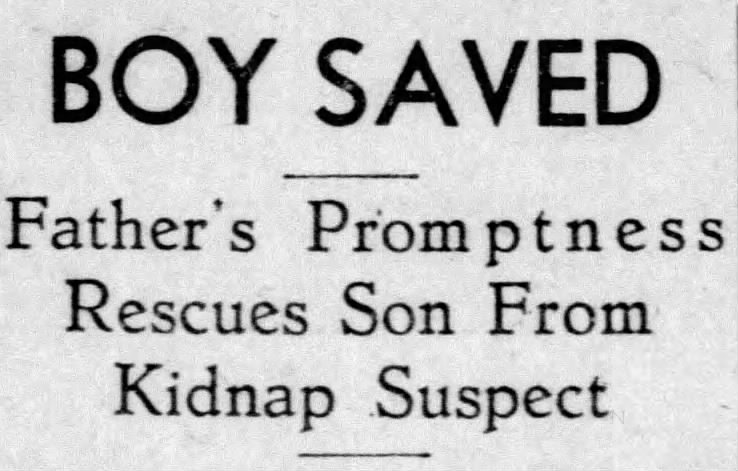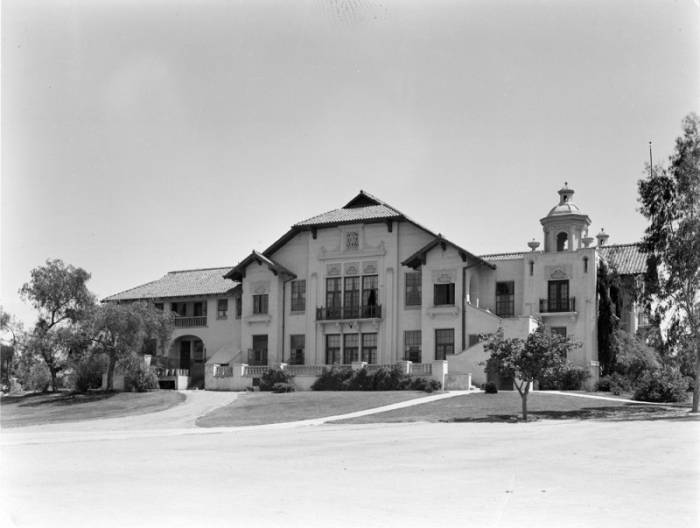While combing old newspapers in search of a tale for a Deranged L.A. Crimes post, I found the curious story of Olney Le Blanc.
On January 28, 1935, a picture of him with his son, Bernard, ran in the Los Angeles Times alongside a headline about a suspected kidnapping and arrest.

The day before the article appeared, 3-year-old Bernard Le Blanc was playing with his two-month-old puppy in his backyard. Moments later, a neighbor, John Corbett, saw Bernard walking down the alley hand in hand with a stranger who had a burlap sack thrown over his shoulder.
Alarmed, Corbett dashed over to Olney’s home and told him what he had witnessed. Olney, Corbett, and a group of neighbors rallied. They chased the man, and Olney caught him. A professional dancer, Olney was in prime physical condition and apprehended the stranger with ease. A fistfight broke out after the vendor resisted. The man was no match for a father in defense of his son. The neighbors held him for police. In the sack they found Bernard’s puppy, dead.
The stranger identified himself as 40-year-old Jack Light, a fruit vendor who lived at 401 1/2 North Main Street. He told police he was drinking before he saw Bernard and his puppy. Light insisted he only wanted to take Bernard to a local café for a bottle of milk, and to a store to buy food for the puppy. He claimed Bernard put the dog, still alive, in the burlap sack and denied kicking it to death. He said when Olney knocked him down, he must have fallen on the sack and crushed the dog’s head. Witnesses contradicted Light’s version.

Detectives Brown and Filkas arrested Light for attempted kidnapping.
In February, Jack Light, acting as his own attorney, took the stand on his own behalf. Charged with child stealing, he told Municipal Judge Morgan Gaibreth the same story he had told police. The judge set Light’s bail at $5000.
On March 20, 1935, Judge Fletcher Bowron found Light guilty of child stealing. Light requested probation. Judge Bowron sentenced him to ninety days in the County Jail, ten years’ probation, and fined him $25.
There is no way to know for sure what Light planned to do with Bernard. That he kicked the puppy to death leads me to believe he was going to harm Bernard, too. Olney’s swift action saved his son from an uncertain fate

Olney’s courage impressed me. I wanted to know if he did anything else worthy of newspaper coverage. I found a few stories about Olney and his dance career. He must have been talented to stay employed during the Depression.
By October 1936, Olney taught dance at the Torrance Recreation Department. The Get-Together Club was part of a WPA (Works Progress Administration) effort. He taught classes from 3:30 to 5:30 p.m., each weekday.
Olney’s dance partner, Coral King, threw a birthday party for him in August 1939 at the Redwood Ranch, home of Lita Houghton in Van Nuys. The party was formal dress, with a live band. Among those in attendance was Coral’s dance class, the Friday Nighters.
The 1940 Federal Census shows Olney as the recreation leader at the McKinley Home for Boys at 13840 Riverside Drive in Van Nuys (now Sherman Oaks). He stated he was married, but his living alone at the home suggests a separation from his wife.

The McKinley Home (named after President McKinley), housed 150-250 boys. In the early 1960s, the home moved to San Dimas and still operates today. They leveled the Van Nuys location and built a mall in its place.
Other than a possible crack in his marriage, Olney appeared to be doing well.
Curious, I searched for further information.
I was unprepared for what I found.
NEXT TIME: Olney’s life takes a turn to the dark side.




